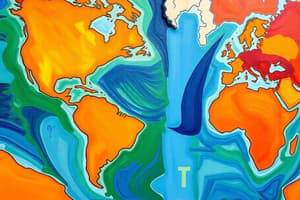Podcast
Questions and Answers
Which term refers to the large-scale exchange of plants, animals, and diseases between the Americas and Europe following Columbus's voyages?
Which term refers to the large-scale exchange of plants, animals, and diseases between the Americas and Europe following Columbus's voyages?
- Astrolabe
- Navigation
- Columbian Exchange (correct)
- Demolish
Who is known as the Portuguese navigator famous for his circumnavigation of the Earth?
Who is known as the Portuguese navigator famous for his circumnavigation of the Earth?
- Vasco da Gama
- Christopher Columbus
- Ferdinand Magellan (correct)
- Hernan Cortes
What was the main purpose of the expeditions led by conquistadors like Hernan Cortes and Francisco de Coronado?
What was the main purpose of the expeditions led by conquistadors like Hernan Cortes and Francisco de Coronado?
- To establish trade routes.
- To spread Christianity.
- To create plantations.
- To conquer and claim territory. (correct)
Which individual is recognized for discovering the Americas in 1492, although he believed he had reached Asia?
Which individual is recognized for discovering the Americas in 1492, although he believed he had reached Asia?
What significant technological advancement greatly improved sea travel during the Age of Exploration?
What significant technological advancement greatly improved sea travel during the Age of Exploration?
Flashcards are hidden until you start studying
Study Notes
Exploration and Navigation
- The Astrolabe was a key instrument for navigation, used to determine latitude by measuring the angle of celestial bodies.
- The Caravel was a small, highly maneuverable ship that enabled faster and more efficient exploration during the Age of Discovery.
European Empires and Colonization
- The establishment of Merchant Colonies was central to expanding trade networks and resource exploitation.
- Empires expanded through colonization, driven by economic interests and competition among European powers.
Trade and Economy
- The Columbian Exchange refers to the widespread transfer of plants, animals, culture, and diseases between the Americas and the Old World post-1492.
- Trade in Enslaved People became a profitable but tragic aspect of the mercantile system, contributing to the economies of European powers.
Key Figures in Exploration
- Prince Henry of Portugal, known as the Navigator, played a significant role in early explorations and the development of maritime routes.
- Ferdinand Magellan was the first to circumnavigate the globe, proving the vastness of the earth and the interconnectedness of oceans.
- Hernan Cortes led the expedition that resulted in the fall of the Aztec Empire, drastically altering the landscape of Mesoamerica.
- Francisco de Coronado explored the southwestern United States, searching for the mythical Seven Cities of Gold.
- Juan Ponce de Leon is credited with the first European contact with Florida while seeking the Fountain of Youth.
- Hernando de Soto was known for his exploration of the southeastern United States and interactions with indigenous tribes.
- Vasco da Gama was the first to sail directly from Europe to India, opening up lucrative trade routes.
Historical Context and Impact
- The Epidemic of diseases introduced by Europeans had a devastating effect on indigenous populations in the Americas, leading to significant demographic shifts.
- Distinct cultural interactions emerged as a result of exploration, shaping the identities and societies of both the colonizers and the indigenous peoples.
- Expeditions were often organized endeavors backed by monarchs or wealthy patrons seeking new lands and wealth.
Legacy of Exploration
- Conquistadors represented the militaristic expansionist spirit, often driven by personal ambition and the pursuit of wealth.
- Leif Ericsson is believed to be the first European to land in North America, centuries before Columbus, highlighting early trans-oceanic exploration.
Studying That Suits You
Use AI to generate personalized quizzes and flashcards to suit your learning preferences.




